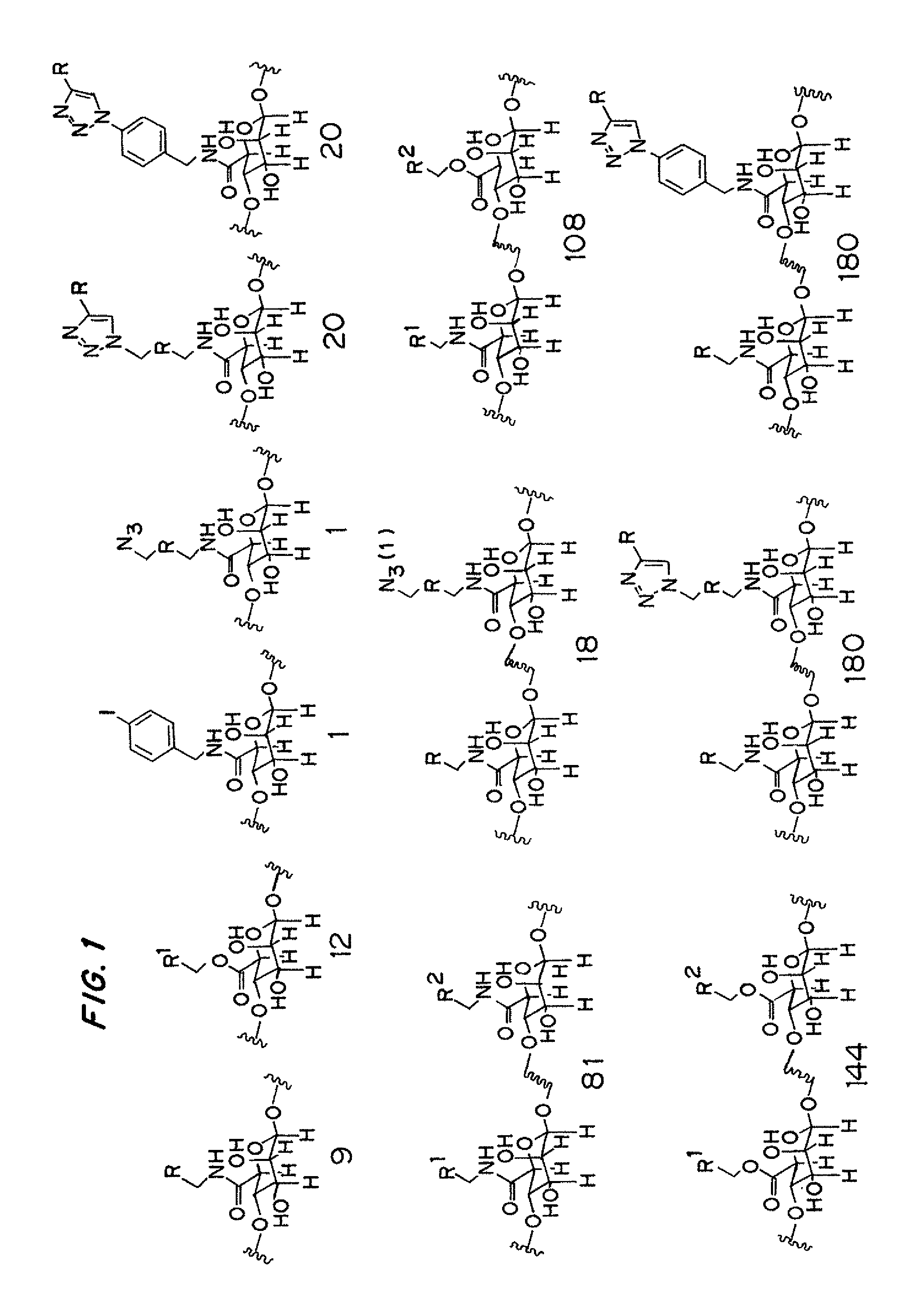Modified alginates for cell encapsulation and cell therapy
a cell encapsulation and cell technology, applied in the field of cell encapsulation and cell therapy, can solve the problems of reducing the efficacy of implanted cells over time, unable to achieve better results with other materials, and difficult efforts to translate these therapies into human subjects, etc., to achieve the effect of improving biocompatibility and tailoring physiochemical properties, gel stability, and pore siz
- Summary
- Abstract
- Description
- Claims
- Application Information
AI Technical Summary
Benefits of technology
Problems solved by technology
Method used
Image
Examples
example 1
Combinatorial Synthesis of Chemically Modified Alginates
[0195]The determinate parameters governing material biocompatibility are poorly understood. Accordingly, the rational design and synthesis of modified alginates possessing improved biocompatibility is challenging. In an effort to identify modified alginates with improved biocompatibility and physical properties, a combinatorial approach was used to prepare a library of modified alginates possessing a range of covalent modifications.
[0196]1. General Combinatorial Strategy
[0197]A pool of twelve alcohols, nine amines, two amines used to introduce an azide moiety (one amine containing an azide moiety and one amine containing an iodide moiety to be converted to an azide moiety subsequent to amidation), and nineteen alkynes with a range of different chemical structures, hydrophobicities / hydrophilicities, hydrogen-bonding potentials, and charge states were selected as reagents for the combinatorial synthesis of modified alginates. Wit...
example 2
High Throughput Screening of Modified Alginates Using a Hydrogel Formation Assay
[0207]Covalent modification of the alginates affects the physical properties of the alginate, including the ability of the alginate to form hydrogels suitable for the encapsulation of cells and biomolecules. To eliminate modified alginates that have lost their ability to form hydrogels and to further focus our screening efforts on stronger candidates, a fluorescence-based crosslinking assay was used to quantify the ability of modified alginates to form hydrogels.
[0208]The hydrogel formation assay described herein exploits the ability of hydrogels to trap fluorescent compounds, and differentially retain the fluorophores upon washing based on the stability of the hydrogel. Each of the modified alginates prepared using the combinatorial approach described in Example 1 was dissolved in water. A rhodamine dye that fluoresces at 580 nm was added to each sample. The modified alginate sample was then crosslinked...
example 3
In Vitro Screening of Modified Alginates for Biocompatibility
[0210]The cytotoxicity of the modified alginate polymers on HeLa cells was evaluated to screen for biocompatibility in vitro. The modified alginates identified in Example 2 as capable of forming hydrogels were loaded into wells of 96-well plates which were coated with poly-L-lysine. Unmodified alginate and saline were also loaded into wells of 96-well plates which were coated with poly-L-lysine as controls. A 100 mM BaCl2 crosslinking solution was dispensed in all of the wells of the 96-well plate. The excess crosslinker was then aspirated. HeLa cells were seeded into the wells and incubated for 3 days at 37° C. in a humidified chamber.
[0211]A cell viability assay using 3-(4,5-Dimethylthiazol-2-yl)-2,5-diphenyltetrazolium bromide (MTT) was performed, in which the media was aspirated from all wells and 100 μl of DMEM media without phenol red and 10 μl MTT (5 mg / ml) were added to all of the wells of the 96-well plate. The pl...
PUM
| Property | Measurement | Unit |
|---|---|---|
| contact angle | aaaaa | aaaaa |
| contact angle | aaaaa | aaaaa |
| weight average molecular weight | aaaaa | aaaaa |
Abstract
Description
Claims
Application Information
 Login to View More
Login to View More - R&D
- Intellectual Property
- Life Sciences
- Materials
- Tech Scout
- Unparalleled Data Quality
- Higher Quality Content
- 60% Fewer Hallucinations
Browse by: Latest US Patents, China's latest patents, Technical Efficacy Thesaurus, Application Domain, Technology Topic, Popular Technical Reports.
© 2025 PatSnap. All rights reserved.Legal|Privacy policy|Modern Slavery Act Transparency Statement|Sitemap|About US| Contact US: help@patsnap.com



